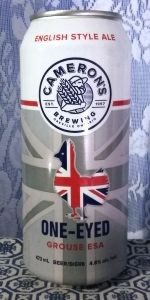This list of the Top 10 English Bitters is based on results from the U.S. Open Beer Championship, Great American Beer Festival, and World Beer Cup. English Bitters are a traditional British beer style known for their balance, low alcohol content, and drinkability.
There are two main subcategories: Ordinary Bitter and Best Bitter. These beers typically feature low gravity, low carbonation, and an easy-drinking profile. While some may lean slightly malty, the defining characteristic is a noticeable but smooth bitterness, with emphasis on early hop additions rather than the bold hop flavors of American ales.
ABV: 3.0% – 4.8%
IBU: 20 – 45
Whether you’re a fan of sessionable ales or classic British styles, these bitters deliver flavor without overwhelming strength—perfect for those seeking balance and tradition in every pint.

1. Surly Bitter Brewer – Surly Brewing – Minnesota
2. One Eyed Grouse – Cameron’s Brewing – Ontario
3. DBA – Firestone Walker Brewing – California
4. Laughing Skull Amber – Red Brick Brewing – Georgia
5. Lyon Pride – Third Monk Brewing – Michigan
6. Special Bitter – Redwood Curtain Brewing – California
7. Robert Smith’s Smooth – South Park Brewing – California
8. Sawtooth Ale – Left Hand Brewing – California
9. Automatic Amber – Mash Lab Brewing – Colorado
10. Butler’s Bitter – Niagara College Teaching Brewery – Canada
History of English Bitters
English bitters, a style of beer known for its balanced malt and hop character, emerged in the early 19th century during Britain’s Industrial Revolution. As brewing techniques advanced, pale malt became more widely available, allowing brewers to create lighter, hoppier beers compared to the darker porters and stouts of the era. Bitters were initially crafted as a draught ale, served fresh in pubs, with a moderate alcohol content (typically 3-5% ABV) and a distinctive bitterness from English hop varieties like Fuggles and Goldings. By the mid-19th century, bitters gained popularity in England’s pubs, particularly in the South, where they were favored for their refreshing quality and ability to pair with hearty pub fare. The term “bitter” itself reflected the beer’s sharp hop profile, which set it apart from milder ales, and it became a staple of British drinking culture.
In the 20th century, bitters evolved with changing tastes and brewing practices, though they faced challenges from the rise of lagers and industrial brewing. The Campaign for Real Ale (CAMRA), founded in 1971, played a crucial role in reviving traditional bitters, championing cask-conditioned ales served at cellar temperature with natural carbonation. This movement helped preserve regional variations, such as the malty, low-hopped bitters of the Midlands and the drier, hop-forward versions from Kent. Today, English bitters remain a cornerstone of British beer culture, celebrated for their sessionable nature and complex flavors, ranging from biscuity malt sweetness to earthy, floral hop notes. While modern craft brewers experiment with the style, traditional bitters continue to thrive in pubs, embodying a centuries-old legacy of craftsmanship.
Top 10 Beers in America – Ales Lagers Specialty Barrel Aged